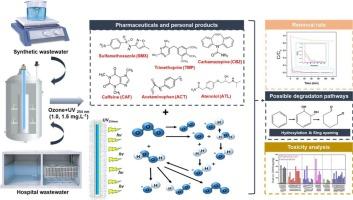Simultaneous degradation of pharmaceuticals and personal care products in hospital wastewater using ozone under ultraviolet irradiation
IF 6.3
2区 工程技术
Q1 ENGINEERING, CHEMICAL
引用次数: 0
Abstract
The discharge of Pharmaceuticals and personal care products (PPCPs) from industries and hospitals are responsible for the contamination of water body with slow or non-degradable toxic compounds. The removal of these contaminants required advanced treatment process because of unable to treat by conventional wastewater treatment process. In this study, the degradation of PPCP compounds, including caffeine (CAF), atenolol (ATL), carbamazepine (CBZ), sulfamethoxazole (SMX), trimethoprim (TMP), and acetaminophen (ACT) was evaluated under exposure to 1.0 and 1.5 mg/L dissolved ozone (O3), both with and without ultraviolet (UV) irradiation (254 nm). Using liquid chromatography with tandem mass spectrometry, we determined that the removal efficiency for the targeted contaminants exceeded 95 % within just 20 min of exposure to both 1.0 and 1.5 mg/L O3. However, when treated with UV light alone, the removal efficiency was limited at 3 %–11 %. A combination treatment involving dissolved 1.5 mg/L O3 and UV light led to over 97 % removal within 7 min. This outcome was attributed to hydroxylation reactions, aromatic ring opening, oxidation, and mineralization facilitated by the HO![]() and peroxide generated through the photolysis of O3. The degradation rate of PPCP compounds followed pseudo-first-order kinetics and showed a decrease in the presence of humic acid and hospital wastewater further decreased it. Moreover, O3/UV treatment generated lower-weight degradation products. The toxicity analysis revealed that these transformation products exhibited environmental benignity and minimal health risks which O3/UV treatment potentially minimizes the presence of harmful byproducts. These findings provide a foundation for developing combined hybrid systems for PPCP containing wastewater, containing membrane filtration with ozonation system.
and peroxide generated through the photolysis of O3. The degradation rate of PPCP compounds followed pseudo-first-order kinetics and showed a decrease in the presence of humic acid and hospital wastewater further decreased it. Moreover, O3/UV treatment generated lower-weight degradation products. The toxicity analysis revealed that these transformation products exhibited environmental benignity and minimal health risks which O3/UV treatment potentially minimizes the presence of harmful byproducts. These findings provide a foundation for developing combined hybrid systems for PPCP containing wastewater, containing membrane filtration with ozonation system.

在紫外线照射下使用臭氧同时降解医院废水中的药物和个人护理产品
工业和医院排放的药品和个人护理产品(PPCPs)是造成水体受到缓慢或难降解有毒化合物污染的原因。由于传统的废水处理工艺无法处理这些污染物,因此需要先进的处理工艺来去除这些污染物。本研究评估了在 1.0 毫克/升和 1.5 毫克/升溶解臭氧(O3)(紫外线(254 纳米)照射或不照射)条件下,PPCP 化合物(包括咖啡因(CAF)、阿替洛尔(ATL)、卡马西平(CBZ)、磺胺甲恶唑(SMX)、三甲氧苄啶(TMP)和对乙酰氨基酚(ACT))的降解情况。利用液相色谱-串联质谱法,我们确定在暴露于 1.0 和 1.5 mg/L O3 的短短 20 分钟内,目标污染物的去除率超过 95%。然而,如果仅使用紫外线处理,去除效率则仅限于 3 %-11 %。将溶解的 1.5 毫克/升 O3 和紫外线结合起来处理,7 分钟内的去除率超过 97%。这一结果归因于羟基化反应、芳香环打开、氧化以及 O3 光解产生的 HO 和过氧化物促进的矿化。PPCP 化合物的降解速率遵循伪一阶动力学,在腐殖酸存在的情况下,降解速率有所下降,而医院废水则进一步降低了降解速率。此外,O3/紫外线处理会产生重量较轻的降解产物。毒性分析表明,这些降解产物对环境无害,对健康的危害极小,因此 O3/UV 处理有可能最大限度地减少有害副产物的存在。这些发现为开发包含膜过滤和臭氧系统的组合混合系统处理含 PPCP 的废水奠定了基础。
本文章由计算机程序翻译,如有差异,请以英文原文为准。
求助全文
约1分钟内获得全文
求助全文
来源期刊

Journal of water process engineering
Biochemistry, Genetics and Molecular Biology-Biotechnology
CiteScore
10.70
自引率
8.60%
发文量
846
审稿时长
24 days
期刊介绍:
The Journal of Water Process Engineering aims to publish refereed, high-quality research papers with significant novelty and impact in all areas of the engineering of water and wastewater processing . Papers on advanced and novel treatment processes and technologies are particularly welcome. The Journal considers papers in areas such as nanotechnology and biotechnology applications in water, novel oxidation and separation processes, membrane processes (except those for desalination) , catalytic processes for the removal of water contaminants, sustainable processes, water reuse and recycling, water use and wastewater minimization, integrated/hybrid technology, process modeling of water treatment and novel treatment processes. Submissions on the subject of adsorbents, including standard measurements of adsorption kinetics and equilibrium will only be considered if there is a genuine case for novelty and contribution, for example highly novel, sustainable adsorbents and their use: papers on activated carbon-type materials derived from natural matter, or surfactant-modified clays and related minerals, would not fulfil this criterion. The Journal particularly welcomes contributions involving environmentally, economically and socially sustainable technology for water treatment, including those which are energy-efficient, with minimal or no chemical consumption, and capable of water recycling and reuse that minimizes the direct disposal of wastewater to the aquatic environment. Papers that describe novel ideas for solving issues related to water quality and availability are also welcome, as are those that show the transfer of techniques from other disciplines. The Journal will consider papers dealing with processes for various water matrices including drinking water (except desalination), domestic, urban and industrial wastewaters, in addition to their residues. It is expected that the journal will be of particular relevance to chemical and process engineers working in the field. The Journal welcomes Full Text papers, Short Communications, State-of-the-Art Reviews and Letters to Editors and Case Studies
 求助内容:
求助内容: 应助结果提醒方式:
应助结果提醒方式:


